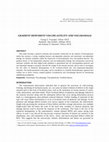Papers by Anthony Palazotto
Proceedings of the 5th International Congress on Computational Mechanics and Simulation, 2014

The effective use of existing Finite Element Codes in the direct simulation of hypervelocity impa... more The effective use of existing Finite Element Codes in the direct simulation of hypervelocity impacts by projectiles is limited by the dependence of the size of localized failure regions on the mesh size and alignment. This gives rise to a non-physical description of the penetration and perforation processes. A micromechanical constitutive model that couples the anisotropic thermo-viscodamage mechanism with the thermo-hypoelasto-viscoplastic deformation will be presented as a remedy to this situation. Explicit and implicit microstructural length scale measures, which preserve the well-posed nature of the differential equations, are introduced through the use of the viscosity and gradient localization limiters. Simple and robust numerical algorithms for the integration of the constitutive equations will be also presented. The proposed unified integration algorithms are extensions of the classical rate-independent return mapping algorithms to the rate-dependent problems. A simple and direct computational algorithm is also used for implementing the gradient-dependent equations. This algorithm can be implemented in the existing finite element codes without numerous modifications as compared to the current numerical approaches for integrating gradient-dependent models. Model capabilities are preliminarily illustrated for the dynamic localization of inelastic flow in adiabatic shear bands and the perforation of Weldox 460E steel plates with various thicknesses by a deformable blunt projectile at various high impact speeds.

50th AIAA/ASME/ASCE/AHS/ASC Structures, Structural Dynamics, and Materials Conference, 2009
This research is directed towards an understanding of the high speed interaction effects that two... more This research is directed towards an understanding of the high speed interaction effects that two bodies have on each other. The experimental high-speed test track at Holloman AFB has undergone many design innovations over a span of fifty years. One of the problems that remain in the modern era related to improving the speed characteristics of a rocket test sled is the wear that the interconnecting device, called the slipper, undergoes as it slides down the rail. The research is separated into two main areas. The first is the metallurgical investigation in which the material change is brought about by the surface friction, and the second is the finite element analysis that attempts to capture the physics involved in the overall phenomenon. It became evident that the wear is not uniform but is dictated by the evolving aerodynamics of a sled moving at close to 1,500 m/s, the speed considered in this research, creating an uneven wear surface at the interface of the slipper and rail. The finite element analysis is separated into two models, one related to the global effects of movement using a predefined velocity versus time function, and the other depicted by a micro-local collision with a surface asperity. The Johnson-Cook failure criterion is incorporated in ABAQUS to arrive at the results. A method has been established which allows the prediction of wear for a time dependent forcing function obtained through a structural dynamics approach. Preliminary results indicate that the method is sufficiently robust that the physics of the wear process at high speeds is understood, and the physical results are reasonably well represented.

Journal of Dynamic Behavior of Materials, 2016
In numerical modeling of material behavior, deformation is calculated with analytical constitutiv... more In numerical modeling of material behavior, deformation is calculated with analytical constitutive equations. When joined with a failure criterion, simulations can predict plastic stress-strain behavior and eventual fracture of the material. The Air Force Institute of Technology (AFIT) uses the Johnson-Cook empirical constitutive equation and damage criterion to model high speed wear. The Johnson-Cook equations employ material parameters which must be characterized experimentally for each material being simulated for accurate results. This paper describes the testing and analytics used to determine the Johnson-Cook constitutive and damage material coefficients for treated 4130 steel. The flow and damage coefficients are calculated and the results are used to construct a finite element model in ABAQUS. This model is compared against the experimental data for final validation.

A series of computational models and simulations were conducted for determining the dynamic respo... more A series of computational models and simulations were conducted for determining the dynamic responses of a solid metal projectile impacting a target under a prescribed high strain rate loading scenario in three-dimensional space. The focus of this study was placed on two different modeling techniques within finite element analysis available in the Abaqus software suite. The first analysis technique relied heavily on more traditional Lagrangian analysis methods utilizing a fixed mesh, while still taking advantage of the finite difference integration present under the explicit analysis approach. A symmetry reduced model using the Lagrangian coordinate system was also developed for comparison in physical and computational performance. The second analysis technique relied on a mixed model that still made use of some Lagrangian modeling, but included smoothed particle hydrodynamics techniques as well, which are mesh free. The inclusion of the smoothed particle hydrodynamics was intended ...
To insert individual citation into a bibliography in a word-processor, you can open the article, ... more To insert individual citation into a bibliography in a word-processor, you can open the article, select your preferred citation style and drag-and-drop it into the document. ... CONSIDERATION OF THE STRENGTH AND STRUCTURAL CHARACTERISTICS OF FILAMENTARY ...
52nd AIAA/ASME/ASCE/AHS/ASC Structures, Structural Dynamics and Materials Conference, 2011
Journal of Aircraft, 2015
Computational Materials Science, 2015
International Journal of Solids and Structures

This study develops a general consistent and systematic framework for the analysis of heterogeneo... more This study develops a general consistent and systematic framework for the analysis of heterogeneous media that assesses a strong coupling between rate-dependent plasticity and anisotropic rate-dependent damage for dynamic problems within the framework of thermodynamic laws and gradient theories. The gradient theory of rate-independent plasticity and rate-independent damage that incorporates macroscale interstate variables and their higher-order gradients is generalized here for rate-dependent plasticity and rate-dependent damage to properly describe the change in the internal structure and in order to investigate the size effect of statistical inhomogeneity of the evolution-related rate-and temperature-dependent materials. The model presented in this paper can be considered as a feasible thermodynamic approach that enables one to derive various coupled gradient viscoplasticity and viscodamage theories by introducing simplifying assumptions.
54th AIAA/ASME/ASCE/AHS/ASC Structures, Structural Dynamics, and Materials Conference, 2013
45th AIAA/ASME/ASCE/AHS/ASC Structures, Structural Dynamics & Materials Conference, 2004
ABSTRACT

A constitutive equation for strain rate dependent behavior of viscoplastic materials under differ... more A constitutive equation for strain rate dependent behavior of viscoplastic materials under different temperature is presented and implemented in a finite element code. A state variable constitutive equation to calculate the state variable histories from the stress and strain histories is presented. The effect of temperature is included in the constitutive equations. Based on the presented equations, the constitutive model is modified and implemented in the three-dimensional explicit finite element simulation code LS-DYNA to simulate the mechanical response of viscoplastic material. Since this model is implemented in the explicit finite element method it can be used for structural components under impact. Examples of tensile response of Rene 95 and Weldox 460 E steel material are presented in this study. The experimental data are compared with the predicted results calculated from the constitutive model. Good agreement is achieved between them.
49th AIAA/ASME/ASCE/AHS/ASC Structures, Structural Dynamics, and Materials Conference <br> 16th AIAA/ASME/AHS Adaptive Structures Conference<br> 10t, 2008
This study develops a general consistent and systematic framework for the analysis of heterogeneo... more This study develops a general consistent and systematic framework for the analysis of heterogeneous media that assesses a strong coupling between rate-dependent plasticity and anisotropic rate-dependent damage for dynamic problems within the framework of thermodynamic laws and gradient theories. The gradient theory of rate-independent plasticity and rate-independent damage that incorporates macroscale interstate variables and their higher-order gradients is generalized here
Biomedical Engineering I, 1982
Mathematical and Computer Modelling, 1990
The use of the boundary integral technique is extended to cylindrical shells through the thicknes... more The use of the boundary integral technique is extended to cylindrical shells through the thickness shear using the Somigliana's approach. Orthotropic material is also considered. The Green functional approach with its major disadvantage , is 1_











Uploads
Papers by Anthony Palazotto